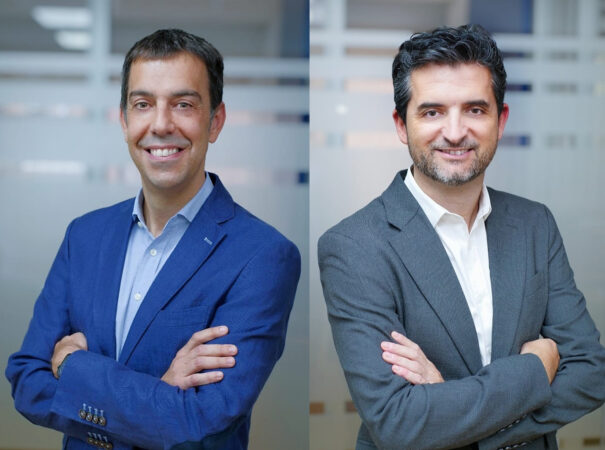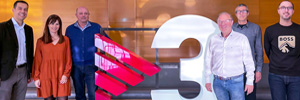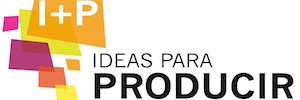Crossmedia: the confluence between broadcast and OTT platforms
Crossmedia, the digital division of Crosspoint and the ES Broadcast group, conducts a detailed analysis of the industry’s status and the digital transformation processes in the transition from broadcast to OTT.
It has been almost four years since the launch of Crossmedia, the digital division of Crosspoint and now part of ES Broadcast. It is a suitable time to conduct an analysis of the evolution of the broadcast industry in the digital environment. For this analysis, we have had a conversation with Víctor García, Managing Director of Crosspoint, and Jorge Frías, Head of Digital Media at Crossmedia, with the intention of taking a snapshot of the current status of the sector and the major challenges posed by the constant technological changes faced by their clients and partners.
Crossmedia, Foundation and Evolution
Years after the launch of Crossmedia, what are the most important reflections on the evolution of this new business line?
Víctor García, Managing Director of Crosspoint: 「The foundation of Crossmedia arose from the need to respond to many challenges posed by the market in various and innovative areas focused on the world of streaming. The idea from its inception was to establish a specialized division in the digital field and try to add that area as part of Crosspoint’s (now within ES Broadcast) solutions portfolio, and that is how it was done during the preliminary stages. However, the growth of this area made the initial approach increasingly complicated, fully justifying the deployment of a new specialized division. After this time, undoubtedly, the first and most solid conclusion is that it has been a clear case of success, where we have expanded our scope of action and conducted truly relevant projects. Today, it is already a well-established area within the group and continues to grow steadily.”
「The second conclusion would be to reaffirm the strategic importance of business diversification, both in expanding our portfolio and areas of operation, as well as opening up to new verticals such as sports, culture, or entertainment. This diversification, along with a commitment to innovation, is crucial for the sustainability of our activity. Today, within the group, we cover all the needs in the broadcast or media world, in addition to acquiring clients in other sectors. Currently, we can offer the well-known ‘glass-to-glass’ solution, which can range from a camera to the CDN distribution service and the app where content is consumed. This also allows us to establish truly relevant synergies among the different companies that are part of the group and offer end-to-end solutions on a global scale. In any case, my colleague Jorge Frías, responsible for this area, can provide you with more details and an interesting analysis of where we see the industry heading.”
After these years since the launch of Crossmedia, what do you consider to be the most important reflections on the evolution of this new business line of Crosspoint?
Jorge Frías, Head of Digital Media at Crossmedia: 「As Víctor mentioned, and looking back a bit since we launched Crossmedia, perhaps the most relevant aspect from a focus perspective has been the ability to serve as that meeting point between the broadcast world and the digital world in the media industry. Crossmedia developed from the idea of acting as a bridge or connection between these two worlds and being the point of convergence between television and the digital domain. In the end, we have assisted in those digital transformation projects in the broadcast world, curiously at the same time or in parallel, with the internal transformation of an engineering company with a long history in the broadcast market like Crosspoint.”
“That is the main focus of Crossmedia, connecting traditional broadcast with the OTT environment そして offering comprehensive solutions ”.
「That is the main focus of Crossmedia, connecting traditional broadcast with the OTT environment and offering comprehensive solutions for cloud-based video platform creation; workflow orchestration for content and metadata; business rule organization and monetization; providing analytics and big data tools; and facilitating content distribution through Content Delivery Networks (CDN) across different windows or applications, among many other things.
「Currently, Crossmedia is a distributor and integrator in Spain of important international firms oriented towards the development and integration of OTT digital platforms. Primarily, our partners’ solutions are focused on Content Distribution Services (CDN); Online Video Platforms (OVP); encoding and packaging systems; Quality of Experience (QoE) measurement tools; analytics applied to OTT and recommendations, or specific Content Management System (CMS) products and applications geared towards video distribution in OTT ecosystems.”
The Transition from Broadcast to the OTT World
It is interesting that you mention the convergence of broadcast and digital platforms, which is now encompassed in the concept of Over-The-Top (OTT). What are the ideas and lessons learned in this transition between both worlds?
Jorge Frías: 「There’s something we always discuss internally and also with our clients. Nowadays, especially in terms of content distribution and consumption, televisions have become applications. The traditional viewer has transformed into a dynamic user who participates in an interactive consumption environment. It is increasingly common to open an app to consume original TV content rather than tune in to a channel on terrestrial TV (TDT). What was once satellite is now a CDN, and that is why having a top-tier CDN for optimal guaranteed distribution has been critical for a while. This ties in with the idea and the need to measure the quality of service and user experience (QoE). In this context, Jonathan Perelman pointed out the idea a while ago with his famous phrase ‘content is king, but distribution is queen, and she wears the pants.’ There is no need to even translate it; it is perfectly understandable. Beyond the content, which is the primary factor, the success and engagement of an OTT platform largely depends on its ability to provide a good user experience. To achieve this, we must use the best tools available in the market and offer quality and, above all, a personalized experience. In a way, it’s also like an integration or synergy between the television and film industries, which have largely been overtaken by the proliferation of digital platforms。」
「On the other hand, as some trends indicate, five major American platforms (Netflix, Disney+, HBO Max, Apple TV+, Prime Video) are on track to capture over 50% of video consumption by 2026. This poses obvious risks of oligopoly and uniformity, considering that we will practically see the same content anywhere in the world. This highlights the importance of niche OTT platforms and the public service function of many of our clients’ platforms, which, with open models, can offer local or regional information and content, a diverse view of the world, and promote content based on the activities and unique culture of many communities. These services deserve to reach more end consumers, and the OTT world, unlike conventional television, allows for global reach in such a large and fragmented ecosystem. Undoubtedly, this has been the purpose of the recent major projects for new OTT platforms that we have witnessed in our environment.」
“Another significant challenge we face as a technological partner to our clients in the transition from broadcast to the OTT world is dealing with cross-functional projects that touch on aspects of both the broadcast and digital sides”.
「Another significant challenge we face as a technological partner to our clients in the transition from broadcast to the OTT world is dealing with cross-functional projects that touch on aspects of both the broadcast and digital sides, thereby affecting very different departments and professional profiles within our clients’ organizational structure. We believe that this is where we add significant value, given the accumulated and joint experience that the Crossmedia-Crosspoint partnership brings. In this regard, we have very interesting projects, such as the one carried out at À Punt, where we provided an end-to-end hybrid broadcast-digital solution, X-Live Panel, to manage the 24×7 and occasional channel publishing from the broadcast hub to the streaming OVP platform for distribution across À Punt’s various platforms. This is a classic example where we had to coordinate with many departments within the organization, both in the traditional broadcast engineering and the digital areas, and where we were able to address a specific need regarding internal workflows. Where many technicians from different departments had to be involved previously, now just one operator without engineering training can operate the system, resulting in time and cost savings for the client.」
Trends and Current Challenges in the Digital Platform Market
What are the most noteworthy trends that you currently detect and that could represent a meaningful change or challenge to address in the short term?
Jorge Frías: 「We believe that the new challenges in the industry are pivoting around four key concepts: the culmination of the transition from the broadcast to the digital world, personalization of the user experience, security, and last but most important, the emergence of AI and its application to the media industry.」
「Regarding the digital transition we discussed earlier, we believe it is just a matter of time before it materializes. As Tim Davie, Director-General of the BBC, and a member of the EBU Executive Board, pointed out when he announced that within approximately a decade, the BBC will be a purely digital service. Traditional broadcasting as we know it, at least in its distribution form, is likely to disappear. On the other hand, the change in the business model is also largely related to the source of advertising revenue, as it shifts from the traditional realm of the DTT model to the digital environment. This is tied to consumption habits and the proliferation of connected TV. When we talk about consumption, it is not only through owned platforms but also through external platforms, which involves distribution through third parties on social media platforms, different from the original content creators’ own media. In fact, there are significant studies, like the one by Houlihan Lokey, indicating that in the United States, advertising investment in OTT platforms is expected to surpass traditional television by 2025。」
「A very interesting example of this convergence is the emergence of linear content in SVOD services, a concept that aims to be marketed as something new and is referred to as FAST channels. At this point, we will not need to teach any of our clients how to create a linear content channel or how to design and set up a playout. The only thing that changes is the medium in which it is distributed, and the approach taken, whether more broadcast-oriented or more digital, and the technology chosen at the time of its creation. There is no doubt that it opens new opportunities for content exploitation and advertising windows, and major industry players like NBCU’s Peacock or Paramount Plus, have adopted this model some time ago。」
「As we mentioned earlier, within the concept of QoE, which, as we have noted, is the queen alongside the king, which is content, there is what we call personalization of the experience. What has been termed QoE was more focused on the purely technical aspects of the service. Nowadays, the challenge we face regarding the quality of the experience goes far beyond that; it involves monitoring not only the video player but the entire application as a whole and understanding what is called the ‘time to first play’ or tracking the user’s journey through your application until they play content. This is crucial when it comes to fueling a recommendation system and being able to offer a personalized experience. Ultimately, any OTT service should aspire to provide a different and specific experience for each of its users, which is the most significant change from broadcast in this area, the transition from the concept of a viewer to the concept of a user as the end customer of the service.」
“This is just the beginning of AI in the media field, and it is likely the tip of the largest iceberg our sector has ever had to face”.
「Security is undoubtedly another key element to consider in the evolution of the service. As broadcast moves to the IP world and cloud services, it becomes necessary to have advanced security tools and services to protect both the original infrastructure and our clients’ content. Regarding this, we are already using state-of-the-art security tools and monitoring systems, as well as other source protection mechanisms, dynamic watermarking systems, and more.」
「Finally, as the most significant disruptive factor, not only in the media environment but also in general, is the emergence of generative Artificial Intelligence (AI) and its significant impact on content generation. Although this subject undoubtedly deserves a specific focus, what we can point out is that we may truly be facing a change in thinking. The most important short-term challenges for our clients, beyond the obvious moral or ethical considerations, will mainly revolve around the protection of the intellectual property of their content, certification of content, or the development of verification and auditing systems. However, above all, it will require necessary and strict government regulation. Currently, our partners are already using AI and machine learning to improve many standard processes in the industry, such as in the encoding layer, applying computational models like DIVA in their encoding systems, or using AI for predicting anomalous behaviors in complex monitoring and supervision systems to generate customized alarms. In any case, this is just the beginning of AI in the media field, and it is likely the tip of the largest iceberg our sector has ever had to face.」
Milestones and Most Notable Projects
You mentioned that during this time, you have undertaken a wide variety of projects of different natures. Could you highlight any of them that have been particularly relevant or interesting?
Jorge Frías: 「It’s true that there’s a great diversity of projects we’ve had to tackle alongside our partners, either as resellers or as solution integrators. These projects have mainly focused on areas such as encoding, packaging, players, analytics, CDN distribution, and the development of CMS (Content Management System) applications. The level of involvement we have had in these projects has been directly related to the client’s internal resources and the complexity of the project itself. Developing an integrated OTT ecosystem within a broadcaster’s workflows is quite complex, and some clients have their own engineering resources where they only require a part of the puzzle, while others need more turnkey solutions with a robust service management layer. It is important to emphasize this service aspect because today’s clients not only need the technological component but also support in using and exploiting that technology effectively and in line with their objectives. As we often colloquially say with our clients, they don’t just need the car, but often the driver as well.」
「In terms of content distribution through CDN, we’d like to highlight the journey we’ve undertaken with our partner Fastly, where we’ve been providing services for some time to RTVE, TV3, EiTB, and others. It is also important to note that at Crossmedia, we add a layer of added value to Fastly’s service with 24×7 support specialized in Varnish and code deployment at the edge with Compute@Edge, as well as value-added solutions leveraging real-time logs provided by the CDN. These include panels and advanced monitoring and control tools tailored to the specific needs of the client. Today, for example, we serve all the web traffic and VOD for RTVE Play through Fastly and we have become a Platinum Partner and are the first European partner to achieve such distinction。
「In the area of encoding and packaging platforms, among others, we provide services to important clients like Mediaset for their live distribution platform, and we are also actively working in other verticals, such as prominent sports content distribution platforms and football clubs.」
「Regarding the development of applications and frontends for complete OTT platforms, we worked on the À Punt OTT platform, integrating from their MAM to the Brightcove OVP platform and delivering content through a custom CMS with multiple publishing windows on Web, iOS, Android, HbbTV, and Smart TVs. We’ve also worked in other verticals, such as the cultural sector, like the Teatro Real, where we provided the complete OVP service with Brightcove and developed custom CMS and applications for distribution on Android TV and LG platforms.」
“Developing an integrated OTT ecosystem within a broadcaster’s workflows is quite complex, and some clients have their own engineering resources where they only require a part of the puzzle, while others need more turnkey solutions with a robust service management layer”.
「Lastly, and of great importance today, in the analytics area, we are immersed in significant projects such as RTVE’s QoE measurement and social media analytics with Conviva, as well as the Data Hub project with Konodrac in CRTVG. It is important to note that both projects come with a significant service layer, given the need for data exploitation to be advised and supported by our partners. The greatest challenge in these cases is not only capturing and aggregating data from various sources, but also turning it into useful data and an operational platform that can activate and provide value to the service. It should serve as an operational tool for many of the client’s departments. There is no doubt today about the relevance of analytics applied to OTT services in this regard. The importance of data and its activation becomes key factors in the paradigm shift in audiovisual consumption。」
「As I mentioned, our scope of action is quite diverse and dynamic because market needs are constantly changing. For example, there are also other specific areas where we are implementing concrete solutions at the player level or for security and origin protection with state-of-the-art WAF solutions.」

Víctor García, Managing Director of Crosspoint (left), y Jorge Frías, Head of Digital Media of Crossmedia (right)
この記事は気に入りましたか?
購読してください RSSフィード 何も見逃すことはありません。
























